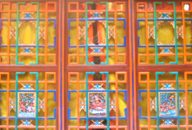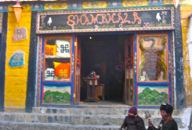House of ShambHala
Barkhor, central lhasa,
EASTERN Tibet, China
November 24-28, 2009


House of ShambHala
Barkhor, central lhasa,
EASTERN Tibet, China
November 24-28, 2009




The House of Shambhala is an attractive, quaint, and “funky” place to stay in Lhasa. Recommended by the New York Times and also listed as a “Top End” place to stay by the Lonely Planet Guide to Tibet, Henry had fortunately booked our stay in here before negotiating the Tibet visa, the Lhasa tour guide and the car and driver, all arranged by our travel contact in Katmandu, Nepal. Our Lhasa guide mistakenly took us to another hotel, Shambhala House, which was Chinese owned. It was one of the most depressing places I’ve seen, though its plaque on the wall rated it the “Best Hotel in Lhasa”, at least for one year this millennium. Henry and I noticed that this hotel was an unacceptable place for us to stay, noting that we had booked was a boutique hotel with only ten rooms, not this much larger establishment. We quickly recognized the error and asked our hotel to call our guide on his mobile phone. He returned, acknowledged this honest mistake of similar names, and delivered us by taxi to the correct address. Thank goodness! House of Shambhala. where we had booked and stayed, is a unique boutique hotel located in the courtyard home that was once an oracle’s shrine. It later became home to Tibetan nobility, a general, a romantic, and a wandering writer. The hotel also had a yoga center, a shop, a spa, and a unique heritage restaurant offering quite a lot of yak on the menu. Our room, #204 on the second floor, was more than we had hoped for. Further investigation over our four night stay revealed a queen sized platform bed that was not a mattress, but was simply a boxed spring with a wooden frame around the edge, pretending to be a futon. Henry confessed to crawling out of bed in the middle of the night to walk around and ease his aching muscles. I simply awoke in pain! Designer features in the bathroom included a rain shower head and a blue-green glass sink that cleverly exposed river rocks stashed on a shelf in the cabinet underneath. There was hot water, but caution was required not to be scalded, since the mixer didn’t work well. Otherwise, the thick, hooded, orange colored robes were cozy, and the monk-robe-colored maroon bath towels were thick and dry. The painted furnishings, the colorful light fixtures, and the spacious, suite-sized room charmed us. As guests, we learned to dress in many layers and to wear a coat and hat to breakfast. An artificial time zone, brought sun up at around 9 AM, so breakfast was served in a cold restaurant with an open door designed to relieve the smoke from a tiny fire, which was stoked in a traditional stove beneath the windows, occasionally propped open for ventilation. Henry and I preferred to take our lunch break on the sunny terrace on the third floor, and to skip dinner, save for a piece of fruit we bought in the local market. Acclimatization to the very high altitude here required time, therefore insomnia, nausea, and headaches were just three of the charming symptoms we weathered with this ailment. We felt marked improvement each day, but decided to forego wine while here, as it is brutal on the body that is already depleted of oxygen. Henry and I both realized how lucky we were to have found this charming place to stay, right in the Barkhor area, a totally Tibetan enclave. We could not have had a better experience in Lhasa, as the staff at House of Shambhala was totally Tibetan, kind, and helpful. The name Shambhala, refers to a mythical paradise, an internal place, thought to be the heaven of the greatest and most masterful Lamas.
PHOTOS: Left Column: 1. Henry, on the roof terrace of House of Shambhala. The colorful thermos was filled with warm welcome of Masala tea, a milky spiced Indian tea. 2. Partial view of the windows of Room 204. 3. Detail: plastered wall on the terrace, embedded with small images of Buddha. 4. Storefront of the Design Shop a retail shop where the interior design elements are made for the hotel. The charming “Save a Tiger” tiger motif rugs are sold here. Center, Top: Interior view of the courtyard, with cast iron grillwork on the stairway. Center, Bottom: Sign for the Tibetan Heritage Restaurant, which is on the 3rd floor of the hotel. Right Column: 1. View from the top of the hotel, the upper terrace, where the Alsatian guard dogs live.2. View of the traditional Tibetan architecture in the old part of the city, the Barkhor area, as seen from the upper terrace of the hotel. All the buildings have clusters of prayer flags, and each has at least one incense burner/heater on its terrace. 3. Window detail with intricate carvings and painted details. 4. The herringbone designed ceiling in bright yellow painted wood, supported by bright blue beams. This same design is found in many monasteries and chapels. It is similar in style (not color) to the ceiling treatment of the Georgia O’Keefe Room at the Mable Dodge Luhan House in Taos, New Mexico., USA. Interesting!


Tibetan Hideaway






